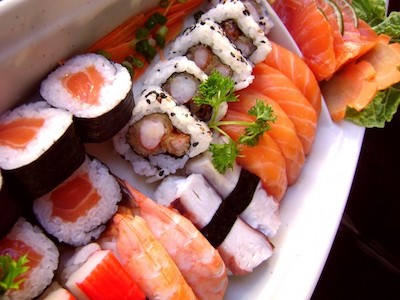We are reader supported. When you purchase through links on our site, we may earn an affiliate commission. Also, as an Amazon affiliate, we earn from qualifying purchases.

If you are a non-Japanese, you will probably think of raw fish when you hear the word sushi. I don’t blame you because 9 out of 10 people will think the same. It’s a common misconception people have about sushi, although there are numerous forms of the delicacy that do not contain raw fish or seafood at all.
So, what does sushi mean in Japanese? It’s an outdated Japanese term that means ‘it’s sour’ and refers to the traditional practice of fermenting rice to preserve the fish. So, sushi gets its name from the sour rice, not raw fish. With the invention of vinegar, people started using vinegar to make rice sour and soon the tasty rice also became an edible part of the dish.
Today sushi rice is known by various names such as sushi meshi, shari, or gohan. It refers to the preparation of white short-grain Japanese rice as this variety has a certain level of stickiness that works in the favor of sushi dishes. The cooked rice is then dressed with vinegar, sugar, salt, sake, and kombu. I have created an article that explains how to make sushi rice in a cooker and pot.
Although sushi has highly evolved from its humble origins more than 600 years ago, the basics have remained the same. Even today, several sushi restaurants in Japan serve the traditional and original form of sushi known as Narezushi. Ardent sushi lovers look at the sushi restaurants in Japan as the mecca where they get to experience the revered food culture at its best.
Contents
Evolution Of Narezushi To Present Form
In the 19th century (Edo period), Hanaya Yohei, a Japanese chef decided to create a version of narezushi that could be easily eaten on the go. It was recreated as a form of fast food for the busy business travelers and passersby’s who did not have the time to sit down and eat a proper lunch at restaurants.
Sushi turned out to be a quick and delicious dish made with freshly caught fish from the Tokyo Bay or Edo-mae, hence it was often referred to as Edomae sushi. As the popularity of sushi grew, more chefs set up their own sushi stalls and they started using fish, seafood, and vegetables as different ingredients with sushi rice.
Today, nigirizushi and makizushi are two of the most popular forms of sushi, but different other versions have been created to woo the westerners. One such popular form is the uramaki or inside-out roll which was invented by a Japanese chef to woo American customers who did not like the appearance or taste of Nori sheets. Hence, the chef cleverly hid the nori under the layer of rice to make the dish appealing to foreigners.
What Sushi Means To Japanese People
The westerners usually think that the Japanese people eat sushi every day. However, this is not the case. The Japanese cuisine is extremely varied, although rice is an important staple that forms the base for many dishes. Sushi is typically considered as a luxury food meant for special occasions. You will rarely find Japanese making nigiri sushi at home because they believe that the chefs have special skills that cannot be replicated at home.

If you walk around a street in Japan, you can find a few sushi restaurants scattered in the neighborhood and some conveyor-belt sushi places that are called kaitenzushi in Japanese. At the same time, you will also find the most expensive sushi bars that promise to give you an experience that you will cherish for a long time.
Unless you choose to do an omakase meal at a high-end sushi bar, the sushi served at the neighborhood outlets are treated like fast food. Just like the burger is to the United States and meat pie is to New Zealand, sushi means the same to the Japanese people. Interestingly, the conveyor-belt outlets and neighborhood shops are more popular than high-end restaurants.
The reason why locals prefer eating sushi at the conveyor-belt outlets is that they offer a quick and easy option to busy people. Unlike a traditional meal, you don’t have to start with appetizers and end with desserts. You may order a cucumber maki and a spicy tuna roll, and that’s more than enough for one person. It takes just about 15-20 minutes to complete a sushi lunch at the neighborhood outlets and this explains their popularity.
An Insight Into The Sushi Culture In Japan
Now that you know the answer to ‘what does sushi mean in Japanese’, let’s take a look into the origins of this dish in Japan. Some historians believe that people started eating sushi n Japan towards the end of the Edo period when the mass production of soy sauce began (1603-1868). Soy sauce worked like a preservative to retain the freshness of raw fish.
When the Great Kanto earthquake hit Japan around 1923, most of the sushi chefs in Tokyo went back to their homes and this style of food spread far and wide throughout the nation. At an average, a Japanese family eats at a sushi restaurant 2-3 times in a month and most of them prefer to go to the conveyor-belt outlets where the food is reasonably priced.
As fresh fish is abundantly available in Japan, people find it a healthier option compared to junk and fried food. No wonder people in Japanese live a longer and healthier life than the rest of the world. Another advantage of eating sushi is that this is a quick-moving food, so you don’t have to wait in long queues.
The same also applies to westerners living in Japan. They prefer eating at sushi restaurants because the food is served quickly and they can have it between lunch breaks in the office. Those who are not comfortable with raw fish have so many other options to choose from, so there’s something for everyone. Wasabi, the hot green paste is a popular condiment among non-Japanese.
Furthermore, there’s no guilt associated with eating sushi because you are mainly eating fish, green veggies, and rice that are all healthy for you. If you love Japanese sake, you will like to know that it pairs well with sushi.
Factors That Contribute To Sushi Boom
Sushi has gone global and how! You can find a sushi restaurant run by Japanese chefs in cities like New York and Dubai, which just goes to show how this cuisine has asserted its popularity around the globe. Here are some of the factors that have contributed to the sushi boom.
# More than just the food, it’s the experience that elates you
The Japanese revere their sushi chefs and hold them in high regard because it takes about 10 years of grueling to achieve the status of a master chef. When a new customer enters a sushi restaurant and sits at the bar, he can feel air respect for the person behind the counter.
It’s a magical experience to see the chef prepare your food right in front of your eyes and being served fresh sushi prepared immediately. The way they mold the rice for nigiri sushi or shape the rice with nori and fillings to create a sushi roll is visually enthralling.
# Indulging in communication with the sushi chef

No other restaurant or food culture allows you to communicate directly with the chef, like a sushi bar. While you enjoy your food and watch the chef in action, you can also give him your direct feedback and indulge in an intriguing conversation.
Most chefs are very responsive towards the feedback received and like to share their knowledge about different types of sushi, fish cuts, etc. However, please ensure that you don’t say anything that may offend the chef. I have created an article on sushi etiquettes, and beginners should check it out to know how to behave properly in a sushi restaurant.
# So many different options for sushi
Food gets interesting when there are different options available and sushi will never disappoint you on that front. You don’t have to stick with a nigiri or sushi roll, but you can also try the various other forms like gunkan maki, uramaki with diverse toppings, inari sushi, temaki sushi and so on. I have created a list of some of the most common types of traditional sushi you can enjoy at the restaurants.
# There’s more to sushi than just raw fish
While most people think raw fish when they hear sushi, there are numerous tasty options for the vegetarians and vegans. I have created an article that contains recipes for making vegetarian sushi at home. If you are a beginner, you may choose to order cooked fish options such as crab meat, surimi, shrimp tempura and so on.
The vegetarians can also enjoy a filling meal at the sushi restaurants as there are numerous options for veggie fillings such as cucumbers, carrots, shitake mushrooms, tofu, baby spinach, sweet potato, pickled vegetables and so on.
# Numerous options for toppings too
If you fall into the category of customers who do not like the appearance of dark green nori outside a sushi roll, there are numerous toppings you can enjoy. The inside-out sushi roll was invented to woo customers like you and impress you will delicious toppings, besides the fillings.
The humble toppings like fish eggs such as ikura and masago can be substituted by rich toppings like shrimp/ crabmeat tempura, raw fish slices (eg. Salmon, tuna, mackerel), veggies (eg. Bell peppers, eggplant, shitake mushrooms) and fruits (eg. Avocado, mango, strawberry, pear). I have created an article that includes 40 topping ideas for those wanting to cook sushi at home.
7 Common Types Of Sushi Served At Restaurants
1. Modern Narezushi
In some Japanese restaurants, you can find the modern take on narezushi, the fermented style of sushi. It comprises of skinned fish seasoned with salt and placed on a wooden barrel. It is weighed down with a heavy pickling stone (tsukemonoishi) and as days pass by, moisture is removed to make it edible for six months or more.
2. Nigirizushi
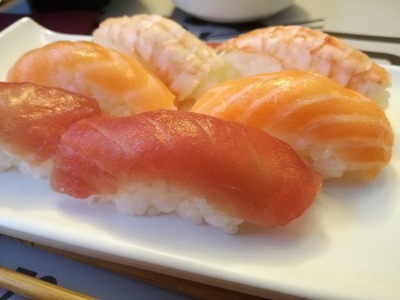
Also known as the hand-pressed sushi, it is made of an oblong-shaped rice bed prepared by pressing sushi rice between the palms. It is topped with a neta or fish, and served with soy sauce and wasabi. The chef already adds a bit of wasabi in between the sushi rice and fish part so be careful about adding any extra. The toppings may be attached to the rice bed with a thin strip of nori, and some of the common options for toppings are freshwater eel, octopus, squid, sea eel, sweet egg, and so on.
3. Gunkanmaki
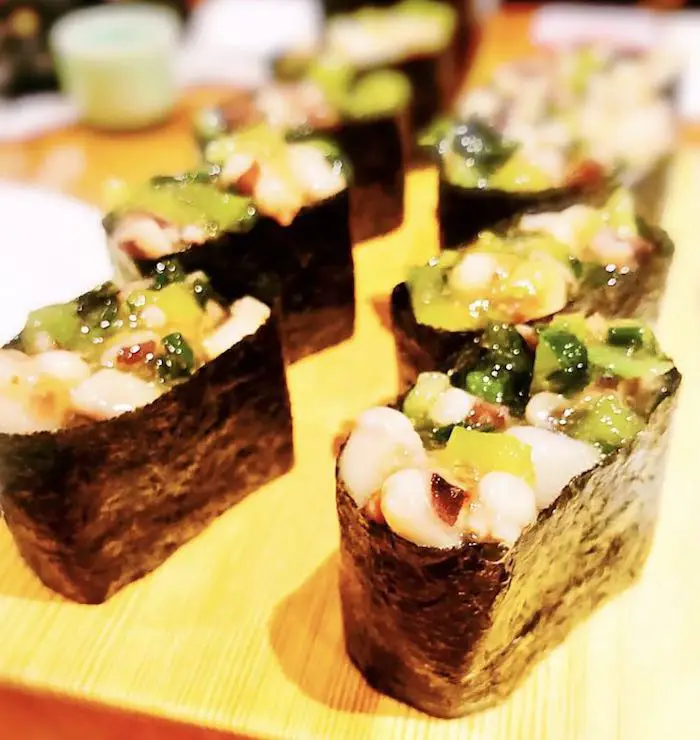
Often referred to as the battleship sushi or warship roll, this is an oval-shaped bed of seasoned sushi rice wrapped in a strip of nori with some empty space on the top to add delicious toppings. Example of ingredients include masago, tobiko, and finely chopped ingredients such as scallops, natto, oysters, uni, and so on.
4. Oshizushi
This is a pressed form of sushi that originated in the Kansai region and it is now considered as a specialty of Osaka. The block-shaped sushi is created using a wooden mold known as oshibako. The chef lines the bottom part of oshibako with toppings and covers with sushi rice. The sushi contains all cured and cooked ingredients, hence its a good option for sushi beginners.
5. Makizushi
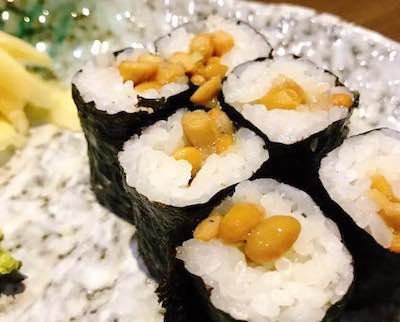
This is the common format that you are probably aware of and something that most people envision when they hear about sushi. Also known as norimaki or makimono, this is a cylindrical form of sushi prepared with the help of a bamboo mat or makisu. This style of sushi is typically rolled in a nori sheet, but sometimes it may be rolled in soy paper or cucumber sheets.
6. Temaki
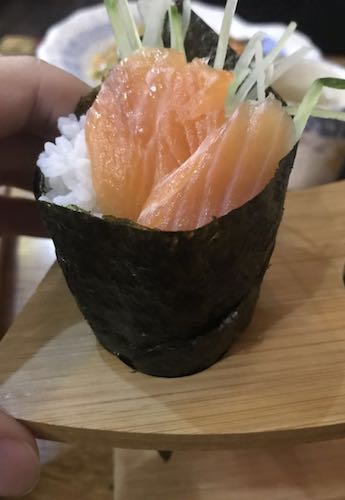
Temaki or hand roll is shaped in the form of a cone with nori on the outside, and sushi rice and fillings inside. This recipe comprises of less rice so anyone looking to cut back on the crabs intake can enjoy this style of sushi. The temaki should be consumed soon because the outer cover absorbs moisture and turns soggy after some time.
7. Uramaki
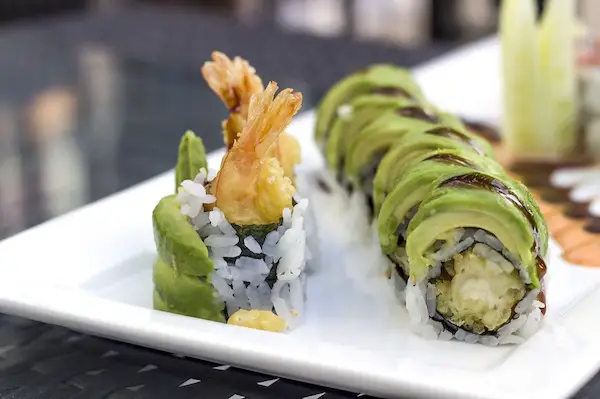
Also known as the inside-out sushi roll, this is a medium-sized roll containing two or more fillings. California roll was perhaps the first style of uramaki ever created and since then, numerous other rolls have been created based on the inside-out concept. Some examples include the rainbow roll, rock n roll, caterpillar roll, and so on.
3 Variations Of Sushi That May Shock You
Who knew sushi could be transformed so drastically to become a burrito or chocolate? The globalization of sushi has sprouted some weird sushi recipes invented by chefs around the world. While the sushi traditionalists may not approve of these but they are fun to try anyway.
1. Sushi burrito
If you are a fan of Mexican burrito, enjoy this appetizing twist with Japanese sushi, resulting in the mouth-watering sushi burritos. The credit for inventing this combination dish goes to a Sushirrito, a San Francisco restaurant that serves sushi burritos every day.
2. Raw horse meat sushi
Ever thought of rolling rice and nori with raw horse meat? If you are a horse lover then I beg your pardon but you will be surprised by the exotic flavors of this delicacy. Raw horse meat is an extremely popular dish in Kumamoto prefecture and using it with sushi has gained immense popularity in recent years.
3. KitKat sushi
Who wants a kitkat sushi break? Does that sound awesome? If you hadn’t thought of combining sweets with sushi even in your wildest dreams, this is a must-try! The KitKat Chocolatory located in Ginza has brought about a new revolution in sushi making by using crispy rice and KitKats. They substitute fish or veggies with an array of sweet flavors such as Hokkaido melon, raspberry, etc.
Related Questions
How is traditional sushi different from the modern ones?
Sushi has spread around the world but interestingly, the western countries have taken a different approach to the traditional dish. Today, you can find sushi that is deep-fried and slathered in an array of mouth-watering sauces. Trying the various forms of sushi in different countries can also be a fun and adventurous experience.
Can sushi make you sick?
Sushi made of raw fish is meant to be consumed immediately when served to you. If you purchased a spicy tuna roll from the grocery store or supermarket, you must eat it immediately after taking it out of the freezing zone. Keeping sushi outside at room temperature for a long can makes it vulnerable to bacterial growth.
Do they have specialty rolls in Japan?
If you visit a sushi restaurant in Japan, you will be surprised to find simple and humble food on the menu. The specialty rolls such as shrimp tempura roll, dragon roll, Boston roll, Philadelphia roll, are the invention of western countries, and the local Japanese do not consider them as authentic.
What are the black and green condiments served with sushi?
The green grainy paste is wasabi that can add some extra kick to your dishes. In Japan, they may serve you real wasabi but the restaurants in the western countries mostly substitute it with horseradish paste mixed with green color. The black-colored sauce is soy sauce, a popular condiment used in Japanese cuisine. Another pink-colored condiment at the side of the dish is pickled ginger that aids in digestion and cleanse your palate in between different types of fishes.

